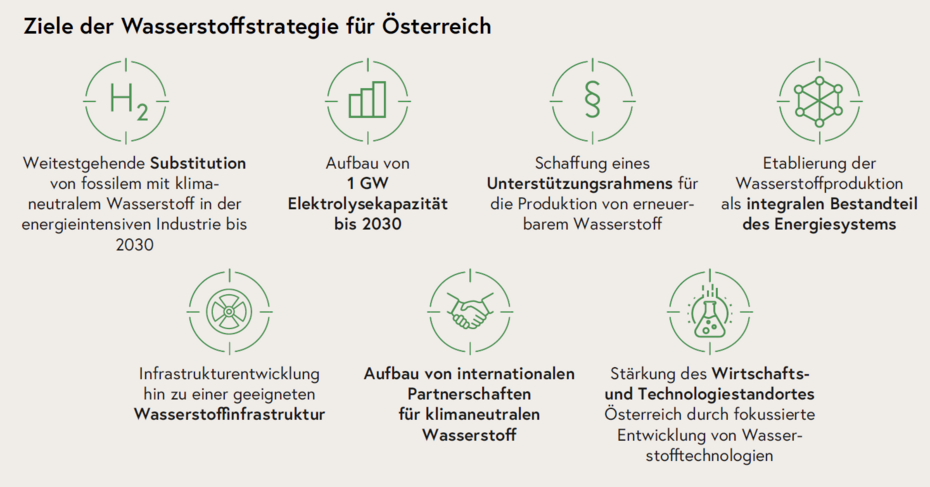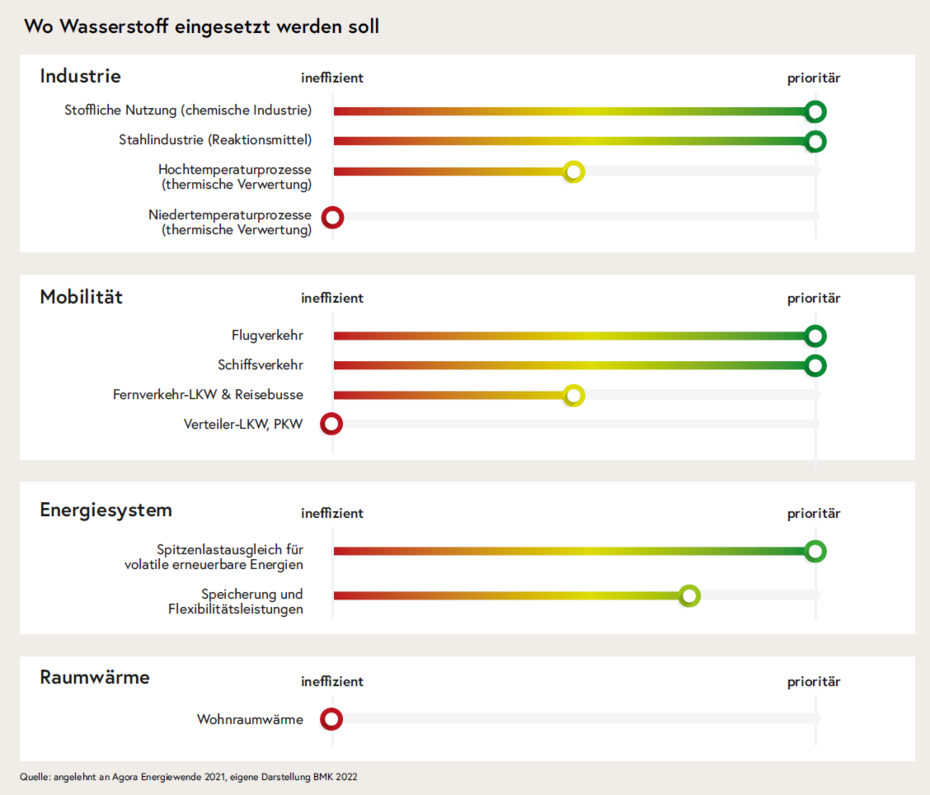Hydrogen strategy for Austria
The Austrian federal government has set itself the goal of achieving climate neutrality by 2040. An energy transition with a significant reduction in energy consumption and a sustainable supply based on renewable energy sources plays a central role across all sectors - from electricity and heat supply to industry and mobility. Climate-neutral hydrogen is an important enabler for this major challenge, which can ensure climate neutrality in sectors that are difficult to decarbonise through various technologies and possible applications and provide significant support on the path to a renewable energy system.
To kick-start the hydrogen economy, the government (lead: BMK, BMAW) presented the National Hydrogen Strategy in June 2022.
A summary is provided below, the full version can be downloaded from the BMK website.
to the full version of the "Hydrogen Strategy for Austria"...
Mission statement

Goals

Climate neutrality in 2040 only with climate-neutral hydrogen
The Austrian federal government's goal is to achieve climate neutrality in Austria by 2040. The transformation of the energy system towards a renewable, efficient and secure energy supply across all sectors is one of the key challenges for achieving this goal. Efficient decarbonisation of the energy system requires different solution concepts due to sector-specific requirements.
With the comprehensive expansion of renewable energies - and the Austrian federal government's goal of covering 100% of the national electricity supply from renewable sources by 2030 - direct electrification is the most efficient option for decarbonisation for numerous applications. Measures to increase energy efficiency and the circular economy should further increase the decarbonisation potential of electrification.
Hydrogen can also represent an important, sustainable option for a secure energy supply for Austria in the future. It can help to ensure the medium and long-term transition away from fossil gas and thus lead to an important reduction in dependence on fossil energy imports.
However, for some important applications in energy-intensive sectors where (direct) electrification is reaching its technical and economic limits, this decarbonisation pathway is not available as an alternative to fossil fuels. For these sectors, in which the material use of energy sources is indispensable, climate-neutral hydrogen is the key to complete decarbonisation. With its function as an energy storage medium, hydrogen also has a fundamental role to play as a building block and pioneer for a renewable energy system.
Climate-neutral hydrogen
Compatibility with the goal of climate neutrality is only possible with climate-neutral hydrogen. In the medium term, this will remain a scarce and high-quality energy source that must be used in a targeted and efficient manner.
In addition to renewable hydrogen,climate-neutral hydrogen also includes hydrogen that is produced from natural gas by means of complete CO2 capture("blue hydrogen") or pyrolysis ("turquoise hydrogen") as soon as the technology is ready. In order to be a usable building block on the path to climate neutrality and in order not to lose its value for use in climate-neutral processes, for example in industry, it must be ensured in the case of hydrogen from natural gas that CO2 capture takes place without the release of greenhouse gases and that all greenhouse gas emissions along the production, transport and processing chains are excluded. It should be noted that "pink hydrogen" from nuclear energy and "blue hydrogen", in which CO2 is captured using nuclear energy, are not sustainable and therefore do not fall into this category.
There are currently two main production paths available for the commercial production of renewable hydrogen and for the key years of the market ramp-up: electrolysis and biogenic hydrogen production through biomass gasification processes. The costs of these production technologies are significantly higher than the costs of fossil hydrogen, both currently and in the short to medium term, which is why investment decisions must be made possible at an early stage by creating a level playing field.
Electrolysis is of particular importance as a sector-coupling technology of the future. By linking the electricity and gas sectors, renewable electricity can be stored in gaseous form and supplied to non-electrified sectors. In the long term, feeding it back into the electricity system represents an option for the seasonal shifting of renewable energy production. The integration of electrolysis plants should also make a balancing contribution to the electricity system by providing grid-supporting system services. The pure operational use of electrolysers for selective production peaks cannot be considered an economically feasible operating model in the foreseeable future, particularly in view of the high future demand for renewable hydrogen.
Prioritising the use of hydrogen

Efficient and focussed use of hydrogen
As an emission-free fuel in fuel cells and combustion processes as well as an important raw material in numerous industrial processes, hydrogen has a broad technical application potential. The many possible uses of hydrogen are currently offset by a limited supply and production potential. In addition, hydrogen must always be considered in the systemic context of alternative decarbonisation strategies in order to use energy as efficiently as possible.
For selected applications in industry and in certain areas of mobility that are difficult to electrify, climate-neutral hydrogen is indispensable as a gaseous energy source and chemical feedstock and represents the most effective way to achieve decarbonisation. Especially in the iron and steel industry, in the chemical industry and generally in high-temperature processes, hydrogen should close important decarbonisation gaps. In mobility, hydrogen and energy carriers produced from it (e-fuels) can completely replace fossil fuels, particularly in the long-distance sector and in air and sea transport.
These sectors, which are difficult to decarbonise, are characterised by considerable energy requirements. The targeted and focused use of climate-neutral hydrogen should maximise the contribution of hydrogen to climate neutrality and secure Austria as an attractive and climate-neutral industrial location with high security of supply and international competitiveness in the long term.
Hydrogen infrastructure
The decisive factor for the efficient and economical use of hydrogen is targeted transport to hydrogen users that is appropriate for the respective application. The utilisation of the existing gas infrastructure for the transport of hydrogen must be considered in a differentiated manner. Adding hydrogen to the gas network (blending) is not expedient in view of the demand for pure hydrogen in the central application sectors. For the pipeline-based transport of hydrogen, the gas infrastructure currently used for natural gas transport should primarily be utilised by converting it into hydrogen pipelines. The construction of new hydrogen pipelines will be examined where there is a lack of corresponding infrastructure and a hydrogen infrastructure is necessary for decarbonisation. Here, particular attention must be paid to embedding it in a pan-European infrastructure development. The local construction of a dedicated hydrogen infrastructure should also enable the supply of industrial clusters and other large-scale consumers in certain areas
Fields of action for implementing the hydrogen strategy
- Enable a timely market ramp-up through showcase projects
- Create support and incentives for the production of renewable hydrogen
- Create incentives for market-based business models and the targeted use of hydrogen in industry
- Develop infrastructure for hydrogen and create import opportunities
- Targeted further development of hydrogen technologies in mobility
- Intensify research and development
- Establish the hydrogen platform H2Austria, now HyPA
- Austria's priorities at European and international level